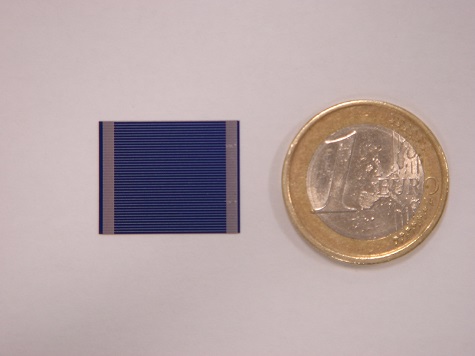There are plenty of alternatives to the traditional flat, rectangular solar PV modules made form glass and Tedlar that are far better suited to equipment design applications that need a different shape, size, weight, appearance or ability to cope in harsh conditions.By Alex Savidis, Applications Manager, Solar Capture Technologies
You could be forgiven for thinking that all solar panels have to be flat, rectangular, and made out of glass and a Tedlar® backing sheet with an aluminium frame. After all, that’s the standard formula for domestic and commercial PV modules. And it’s the traditional pattern followed by pretty much all off-the-shelf solar units available to design engineers for other applications, even if they’re not really appropriate for the job. But why? Is there a good reason for the materials used to be limited in this way?
The reality is that there are plenty of alternatives that are far better suited to equipment design applications that need a different shape, size, weight, appearance or ability to cope in harsh conditions. You just need to know where to look.
A typical PV module used on house roofs, commercial buildings and solar farms is basically a laminate sandwich made up of three components – solar cells, glass and a backing sheet normally made from Tedlar – laminated together with an encapsulant. That’s fine for what they need to do. But would they all be right for integration into a traffic bollard, an offshore buoy or the approach lights used to guide a helicopter onto an oil rig?
More and more solar panels are finding their way into applications where they’re used for autonomously powering devices that can’t be connected to the grid, or where it’s too expensive to do so. But design engineers are often frustrated by the inflexibility of the standard solar units available from catalogues, and their inability to meet the specific characteristics they need – with the risk that designs end up being seriously compromised.
Shape is a common problem. Illuminated traffic bollards, for example, may need a special semi-circular curved shape that’s designed to fit perfectly into the top of the unit. Floating buoys out at sea with flashing beacons call for a circular disc design, with the solar cells arranged into a wide ring. Neither can be achieved with standard components that can only be bolted on. But although solar cells are rigid, it is possible to combine a series of “flats” to form shapes and profiles to suit the desired design.
Weight is another common issue. Pole-mounted devices attached to street furniture for the remote monitoring of emissions can be at risk from high winds if the materials used are too heavy. Portable applications such as charging devices carried to power field equipment like radios or PDAs on expeditions or military excursions also need to be as light as possible. One solution here can be found in the materials used to support the solar cells and give mechanical rigidity. By using aluminium or fibreglass as a substrate, much thinner solar modules can be made.
Wind uplift can be a major problem on solar modules fitted onto luxury motor homes. Off the shelf units made from glass, Tedlar and an aluminium frame have an overall depth of 30 to 40mm and have to be attached with PTFE brackets and adhesive – leaving a gap between the module and the roof that can cause aerodynamic issues. A solar module made from a combination of aluminium and Teflon, bonded directly to the roof, can achieve the necessary rigidity with a thickness of only a few millimetres, no gap, and much less risk of wind uplift.
How about appearance and aesthetics? Glass can be quite reflective, and sometimes attract attention for all the wrong reasons. Solar panels used trackside for rail applications and left unattended in remote stretches are an easy target for vandalism and theft. Military back packs with solar chargers need a discreet design to avoid the risk of glare. In instances like these, a material like Teflon which is duller than glass and can be textured is far more discreet. Another problem with conventional solar modules for this type of application is the shiny silver bus bars that are in stark contrast to the dark blue cells and light coloured substrate. By colouring the bus bars and using black anodised aluminium as a substrate with a textured Teflon cover, it’s possible to make very discreet, dull looking solar panels.
Teflon brings other advantages, too. Unlike glass, it won’t shatter on impact. It has a higher light transmittance than solar glass, with improved light efficiency for higher power output from a smaller module when space is at a premium. All that, and it’s less expensive too. It’s even being used on solar panels for environmental applications in remote camera systems to monitor wildlife.
The encapsulant normally used in standard solar panels is EVA (ethylene vinyl acetate) – a common polymer that’s also found in everything from sunglasses to flip flops. Again this is fine for conventional domestic and commercial solar power uses. But for more especially demanding applications, other specialised encapsulants can also be used.
Think about aerospace applications, for example, where solar panels fitted onto portable runway lights might be in the vicinity of 350 degree heat from the exhaust of a jet engine. Think about solar powered lights for arctic expeditions, or powering GPRS in hot and dusty deserts. For harsh applications like these (as well as many far less demanding ones), conventional solar power units simply won’t cut it.
As a specialised manufacturer of PV cells and custom-made, application-specific solar modules, Solar Capture Technologies produces around 10,000 units per year – in all shapes and sizes, with appropriate electrical output, and in small to medium volumes including proof of concept demonstrations and prototyping. With past roots in NaREC and BP Solar, the business is now completely independent with its own full design and manufacturing facilities – including testing under true atmospheric conditions such as sea water, humidity, and high and low temperatures.
So if you thought that all solar panels have to be flat, rectangular, and only made out of glass, a Tedlar® back sheet and an aluminium frame, it might be time to think again. The solar application that you never thought possible might be well within your reach.
-ends-
[1017 words]
About Solar Capture Technologies:
Solar Capture Technologies is an independent photovoltaic cell and module manufacturer, specialising in Laser Grooved Buried Contact (LGBC) solar cells and custom made off-grid modules. The company also conducts cutting edge, world leading research and development into photovoltaic technologies for both private and public funded projects.
Solar Capture Technologies originated as the Research and Development team within BP Solar, who carried out world leading research into concentrator and laser grooved photovoltaics. In 2003 the team and facilities were transferred to the UK’s National Renewable Energy Centre (Narec), located in Blyth, Northumberland. This transfer involved the build of the PV Technology Centre (PVTC). In 2013 Narec Solar split to become a completely independent organisation, known as Solar Capture Technologies.
Solar Capture Technologies
Photovoltaic Technology Centre
Albert Street
Blyth
Northumberland
NE24 1LZ
Tel: +44 (0) 1670 357 733
Email: enquiries@solarcapturetechnologies.com
Web: http://solarcapturetechnologies.com/
For further information please contact:
Katrin Naefe PR
7 Warkworth Close
Banbury OX16 1BD
United Kingdom
Phone: +44 (0)1295 256138
Mobile: +44 (0)7950 629552
Email: katrin@naefepr.co.uk








